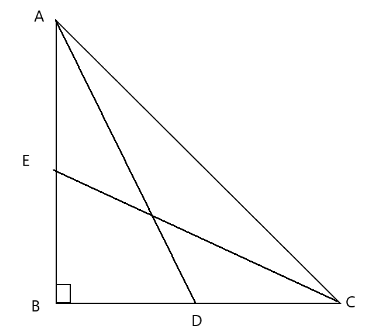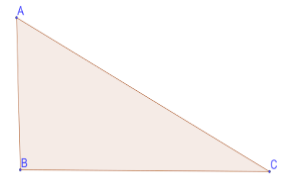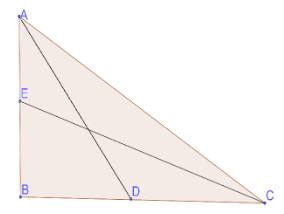
In a right-angled triangle, five times the square on the hypotenuse is equal to four times the sum of the squares on the medians drawn from the acute angles. Prove it.


Answer
575.7k+ views
Hint: In a right-angled triangle, as the Pythagoras theorems say, ${h^2} = {p^2} + {b^2}$, where h is the hypotenuse of a right-angle triangle, p is the perpendicular and b is the base.
Complete step-by-step answer:
Consider a right angle triangle, $\vartriangle ABC$

In $\vartriangle ABC$, using Pythagoras theorem, ${h^2} = {p^2} + {b^2}$, where h is the hypotenuse of a right-angle triangle, p is the perpendicular and b is the base.
$A{C^2} = A{B^2} + B{C^2}$
Let AB=x and BC=y
$ \Rightarrow A{C^2} = {x^2} + {y^2}$

AD and CE are the median drawn from A and B respectively.
Now, further applying Pythagoras theorem in $\vartriangle ABD$, we get
$
A{D^2} = {x^2} + {\left( {\dfrac{y}{2}} \right)^2} \\
\Rightarrow AD = \sqrt {{x^2} + {{\left( {\dfrac{y}{2}} \right)}^2}} \\
$
Similarly, In $\vartriangle ECB$,
$
C{E^2} = {y^2} + {(\dfrac{x}{2})^2} \\
\Rightarrow CE = \sqrt {{y^2} + {{(\dfrac{x}{2})}^2}} \\
$
Now, the sum of the squares of the medians is
$
\Rightarrow A{D^2} + C{E^2} = {x^2} + {\left( {\dfrac{y}{2}} \right)^2} + {y^2} + {\left( {\dfrac{x}{2}} \right)^2} \\
\Rightarrow A{D^2} + C{E^2} = \dfrac{5}{4}({x^2} + {y^2}) \\
\Rightarrow 4\left( {A{D^2} + C{E^2}} \right) = 5({x^2} + {y^2}) \\
$
As, we know $A{C^2} = {x^2} + {y^2}$
$ \Rightarrow 4(A{D^2} + C{E^2}) = 5A{C^2}$
Hence, five times the square on the hypotenuse is equal to four times the sum of the squares on the medians drawn from the acute angles
Note: The Median joins the vertex to the midpoint of the opposite side. The properties of the median are as follows:-
The median divides the triangle into two parts of equal area.
The point of concurrency of medians is called Centroid.
The centroid divides the median in the ratio 2:1 with the larger parts toward the vertex.
Complete step-by-step answer:
Consider a right angle triangle, $\vartriangle ABC$

In $\vartriangle ABC$, using Pythagoras theorem, ${h^2} = {p^2} + {b^2}$, where h is the hypotenuse of a right-angle triangle, p is the perpendicular and b is the base.
$A{C^2} = A{B^2} + B{C^2}$
Let AB=x and BC=y
$ \Rightarrow A{C^2} = {x^2} + {y^2}$

AD and CE are the median drawn from A and B respectively.
Now, further applying Pythagoras theorem in $\vartriangle ABD$, we get
$
A{D^2} = {x^2} + {\left( {\dfrac{y}{2}} \right)^2} \\
\Rightarrow AD = \sqrt {{x^2} + {{\left( {\dfrac{y}{2}} \right)}^2}} \\
$
Similarly, In $\vartriangle ECB$,
$
C{E^2} = {y^2} + {(\dfrac{x}{2})^2} \\
\Rightarrow CE = \sqrt {{y^2} + {{(\dfrac{x}{2})}^2}} \\
$
Now, the sum of the squares of the medians is
$
\Rightarrow A{D^2} + C{E^2} = {x^2} + {\left( {\dfrac{y}{2}} \right)^2} + {y^2} + {\left( {\dfrac{x}{2}} \right)^2} \\
\Rightarrow A{D^2} + C{E^2} = \dfrac{5}{4}({x^2} + {y^2}) \\
\Rightarrow 4\left( {A{D^2} + C{E^2}} \right) = 5({x^2} + {y^2}) \\
$
As, we know $A{C^2} = {x^2} + {y^2}$
$ \Rightarrow 4(A{D^2} + C{E^2}) = 5A{C^2}$
Hence, five times the square on the hypotenuse is equal to four times the sum of the squares on the medians drawn from the acute angles
Note: The Median joins the vertex to the midpoint of the opposite side. The properties of the median are as follows:-
The median divides the triangle into two parts of equal area.
The point of concurrency of medians is called Centroid.
The centroid divides the median in the ratio 2:1 with the larger parts toward the vertex.
Recently Updated Pages
The number of solutions in x in 02pi for which sqrt class 12 maths CBSE

Write any two methods of preparation of phenol Give class 12 chemistry CBSE

Differentiate between action potential and resting class 12 biology CBSE

Two plane mirrors arranged at right angles to each class 12 physics CBSE

Which of the following molecules is are chiral A I class 12 chemistry CBSE

Name different types of neurons and give one function class 12 biology CBSE

Trending doubts
Fill the blanks with the suitable prepositions 1 The class 9 english CBSE

What does the word meridian mean A New day B Midday class 9 social science CBSE

What is the full form of pH?

Write the 6 fundamental rights of India and explain in detail

Which places in India experience sunrise first and class 9 social science CBSE

What is pollution? How many types of pollution? Define it




